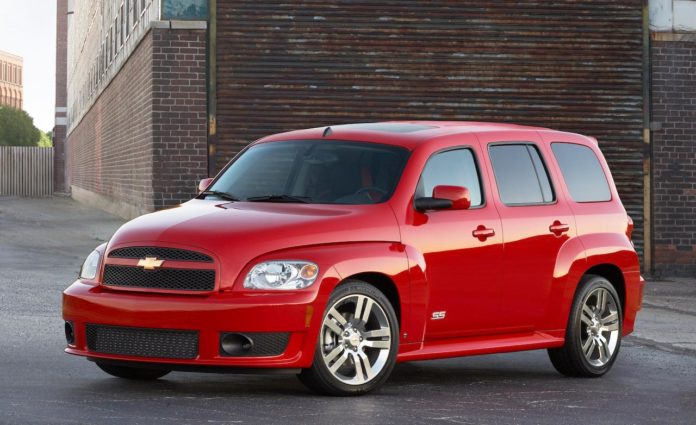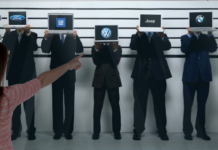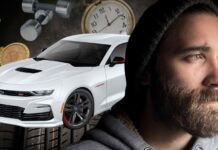I have a very vivid memory from the mid-2000s. I was discussing fashion trends with my friend and I specifically remember saying something along the lines of: “It’s just so crazy to look back on photos from the ‘70s and ’80s and realize that people actually dressed like that. We’re so boring now – there’s nothing about what we are wearing that will ever be dated.”
I’m pretty sure as these words were spilling out of my mouth, I was wearing a Von Dutch trucker hat and my jeans were bedazzled.
Helloooo, 2005!
Looking back, I think there was something in the water in the early-to-mid 2000s. Not only was the fashion just horrendous but the cars that were coming on the market were just mind-bogglingly awful.
Case in point: the Chevy HHR. Never heard of it? You probably blocked it from your memory. It was only available from 2007-2011 because literally no one wanted to drive that car. If you need a frame of reference, it sort of resembled another 2000 horror show – the PT Cruiser. Something about the 2000s really made car manufacturers want to sell weird, boxy cars.
Anyways, they say that those who don’t remember history are doomed to repeat it, so let’s save ourselves from another onslaught of awful cars and take a drive down memory lane in the Chevy HHR.
The Exterior
The inspiration for the HHR supposedly came from the 1949 Suburban – which is one of those things that make you go hmmm. Yeah, we have no idea why Chevy wanted to bring that style back, but so be it. The HHR was basically a wagon with a massive grille and flared fenders. It looked super boxy and like it would have been really expansive on the inside (spoiler alert: it wasn’t). It came in a variety of fairly basic colors but since this was also the age of MTV’s Pimp My Ride, there’s no telling what people actually did to “customize” their cars. In the 2000s, the sky was the limit for making insane modifications to otherwise completely fine cars.
The Interior
If you were in the market for a Chevy HHR, you had your choice of two body styles – the compact four door wagon or the super creepy panel van. I have absolutely no idea why anyone would want the panel van, but apparently people bought them (supposedly they were “work vans” but I think that might be revisionist history). Either way, you also had trim levels to choose from: three trims for the wagon and two for the panel van. Keep in mind this was about a decade ago, because for the time, the HHR was actually considered pretty well-equipped.
The base model HHR wagon, the LS, came with air-conditioning, cruise control, a six-speaker CD stereo, an auxiliary jack, keyless entry, and full power accessories. That’s actually better than you can get on some base models today. If you moved up a trim level to the 1LT, you were enjoying an MP3-compatible stereo (so 2000s!), an eight-way power driver seat and alloy wheels. If you were really fancy and went for the 2LT, you’d be riding on 17-inch wheels, have foglamps, chrome trim, and a seven-speaker Pioneer sound system.
The HHR wagon also had some pretty nice options you could add in like leather upholstery, seat heaters, an in-dash CD changer (can you even buy CDs anymore?) a satellite radio, OnStar, and a sunroof. Also, a rearview camera was touted as optional, but most drivers said it was absolutely essential as visibility left a lot to be desired.
If you decided to weird people out with the panel van, you could choose between the LS and LT trims. They were pretty much identical in that you would get chrome exterior accents, dual rear cargo doors, storage compartments in the load floor and windowless side panels (why!?). Can you even imagine sitting in the backseat of a car that didn’t have windows? Sounds terrible. All the same, the LS and the LT trims closely match the LS and 1LT trim of the wagon – nothing too unique sets them apart.
The HHR in Chevy HHR stands for Heritage High Roof, but tall passengers probably weren’t really feeling the high roof part- the car was known for managing to be both spacious and crammed, simultaneously. However, you did have decent cargo room – 57.7 cubic feet if you collapsed the back seats and 25.2 cubic feet in the regular trunk.
Performance
The Chevy HHR may have been a pretty atrocious design, but it did offer a pretty nice interior set up and it performed reasonably well. Powered by either a 2.2-liter four-cylinder with 149 horsepower or a 2.4-liter engine churning out 175 horsepower, the HHR wasn’t a speed demon or super nippy, but I don’t think anyone looked at the design of the car and expected it to be.
Safety
One thing you can’t take away from the Chevy HHR is that it was a pretty safe car. The 2010 HHR received a five-star rating from the National Highway Traffic Safety Administration and the Insurance Institute for Highway Safety gave it the top rating of “Good.” Of course, compared to the safety technology that is loaded into cars today, the HHR doesn’t have all the bells and whistles that we’ve become accustomed to, but at the time, it was a car you could feel good about driving your kids around in.
Price
Of course, now you can pick up a used HHR for dirt cheap, but in the 2000s the starting MSRP of the HHR hovered around $18,000-$19,000. So, while it wasn’t the most expensive car on the market, it certainly wasn’t the cheapest either.
The End
2011 marked the end of the HHR. Poor sales were the final nail in the coffin for Chevy’s throwback wagon, and although yes, the styling was certainly a little oddball, we can look back now and see that the car wasn’t really all that bad. It was just… awkward.
Then again, the 2000s in general were just awkward (exhibit 1, 2, 3) so maybe it really was the perfect car for the time.












